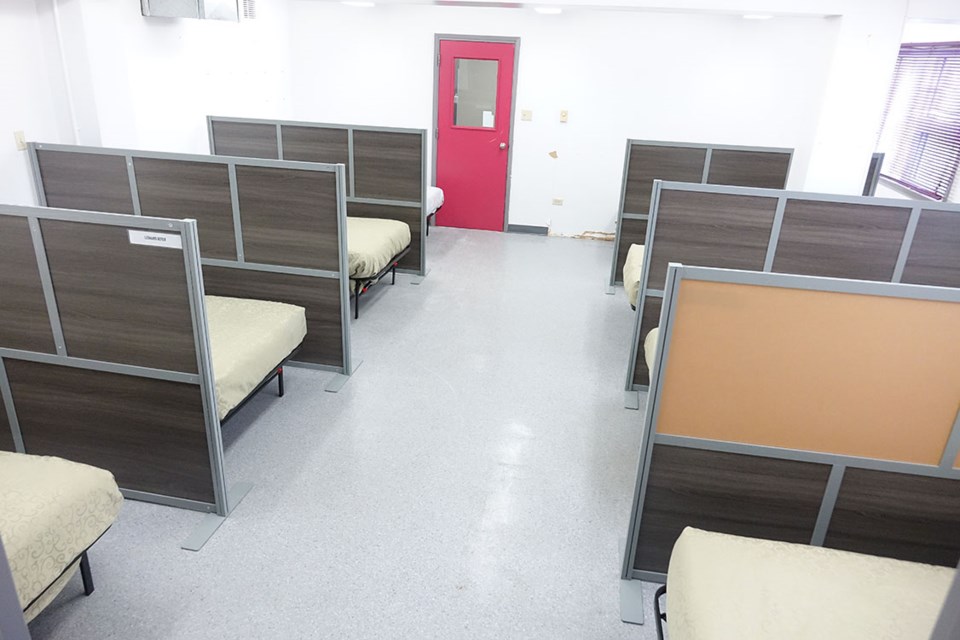The first phase of Thompson’s sobering/healing centre opened the week after Thanksgiving, albeit with a slightly different mission than what at least part of it is eventually intended to be.
As of Oct. 13, one floor of one of the buildings of the old University College of the North campus on the corner of Princeton Drive and Station Road began to house homeless people, some on an emergency basis and some through a shelter in place program currently funded by Vale.
The old Polaris building on the corner — 534 Princeton Drive, which used to be the home of UCN’s library, among other things — is the new location of the emergency shelter formerly situated at the Thompson homeless shelter on Churchill Drive, which offers room for 24 people with nowhere else to stay a spot on a mat on a night-by-night basis.
Another section of the building’s first floor provides longer-term dormitory style housing to chronically homeless people, which is basically an extension of the shelter-in-place program (SHIPP) that saw 25 chronically homeless people housed at the YWCA through the COVID-19 pandemic in an effort to lessen their likelihood of contracting the virus. This program currently has space for 45 residents, about two-thirds of which were expected to be occupied immediately.
On winter nights when the temperature is expected to dip to -35 degrees Celsius or lower overnight, the basement space that used to house the library will be pressed into service to support the city’s cold-weather policy. Previously, people seeking emergency shelter on those ultra-cold nights were accommodated in outdoor ice rink warmup shacks in Eastwood and Juniper parks.
Under normal circumstance, the healing centre now offers space for up to about 70 people. On cold-weather policy eligible nights, that number could swell to about 100 people.
“The space is not ideal … but it is so much better than leaving 100 people out on the street,” YWCA executive director Kim Hickes said during an Oct. 12 open house.
The emergency homeless shelter program is funded mostly by provincial and federal money, though the City of Thompson has contributed up to $20,000 a year towards the homeless shelter in the past. It is operated by the Canadian Mental Health Association, which also oversaw the homeless shelter at its previous location and is in charge of other programs to accommodate people without shelter, such as the so-called “damp house” housing complex at 95 Cree Road.
A $250,000 contribution from Vale is paying for the shelter-in-place program right now.
“Clients will actually live in this section and we’ll provide wraparound services and hep them move towards the goals they’ve identified,” Hickes said.
The eventual goal for the sobering centre, as outlined when the provincial government announced in June 2020 that it would be providing $2.8 million in funding for such a facility, is to provide an alternative to taking publicly intoxicated people to the RCMP detachment drunk tanks or for treatment at the Thompson General Hospital if they aren’t medically fit to be placed in police cells. The goal of this type of a facility will be to relive the amount of strain that alcohol use, abuse and addiction currently place on police and the emergency department.
The RCMP detachment housed nearly 2,500 people under the Intoxicated Persons Detention Act in 2020. Prior to each of these people being lodged in cells, they had to be medically cleared at the hospital or by Thompson firefighter/paramedics. At Winnipeg’s Main Street North facility, people detained for public intoxication are examined by an on-site paramedic who either admits them or sends to them to the hospital for treatment. Those who are admitted are housed there until they are sober enough to be released.
Despite the requirement for medical clearance and safety protocols such as checking on prisoners every 15 minutes and physically waking them up every four hours, two people housed in Thompson RCMP detachment cells have died since February 2020, following a 12-year-period in which no such deaths occurred.
In addition to providing shelter-in-place program participants a more permanent place to stay, the healing centre as it operates now will also provide them with access to mental health and other counselling services and access to traditional healers as well as to medical care via Keewatinohk Inniniw Minoayawin (KIM), Manitoba Keewatinowi Okimakanak’s health organization, said Hickes. There are also hopes that the Northern Regional Health Authority could provide some medical care at the centre.
“We’ll co-ordinate it through the co-ordinator here to make sure there are service providers on site every day for clients to access,” Hickes said Oct. 12.
Unlike residents at some supportive or transitional living residences in Thompson, like the Men Are Part of the Solution facilities for men and woman, shelter-in-place residents are not required to abstain from alcohol or other substances while staying at the healing centre, which will also try to help those who wish to return to their home communities to achieve that goal. Use fo alcohol or other substances inside the building will not be allowed, however.
Eventually, there are plans to construct an entrance to the centre on the western side of the building, instead of using the current entrance, which faces out onto Princeton Drive and toward the Wapanohk Community School playground on the other side of the street.
“We are a harm reduction facility,” Hickes said. “We need safe places for people to use.”
By offering alternatives such as the shelter-in-place program, the healing centre aims to try to reduce the need for emergency shelter services over the long run, said Darren Fulford of the CMHA.
“You really want to try to divert from the shelter,” he said.
For some clients, the goal of finding a permanent place to stay requires more work than it does for others, and Fulford says he hopes there will eventually be a multi-agency panel that will work towards finding solutions for harder-to-house people.
“I think we’re going to try to have, at some point, a complex individuals working group because we have several individuals that are hard to house,” Fulford said.




